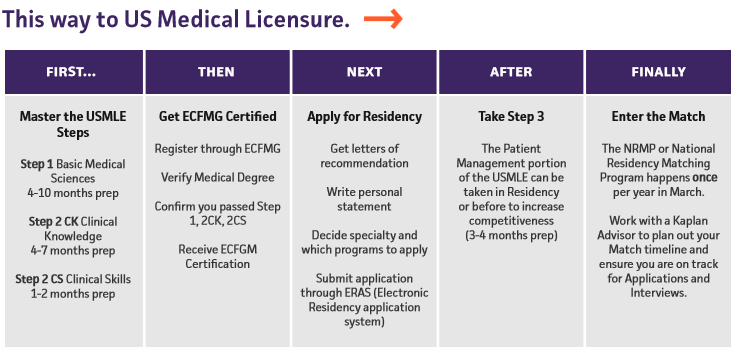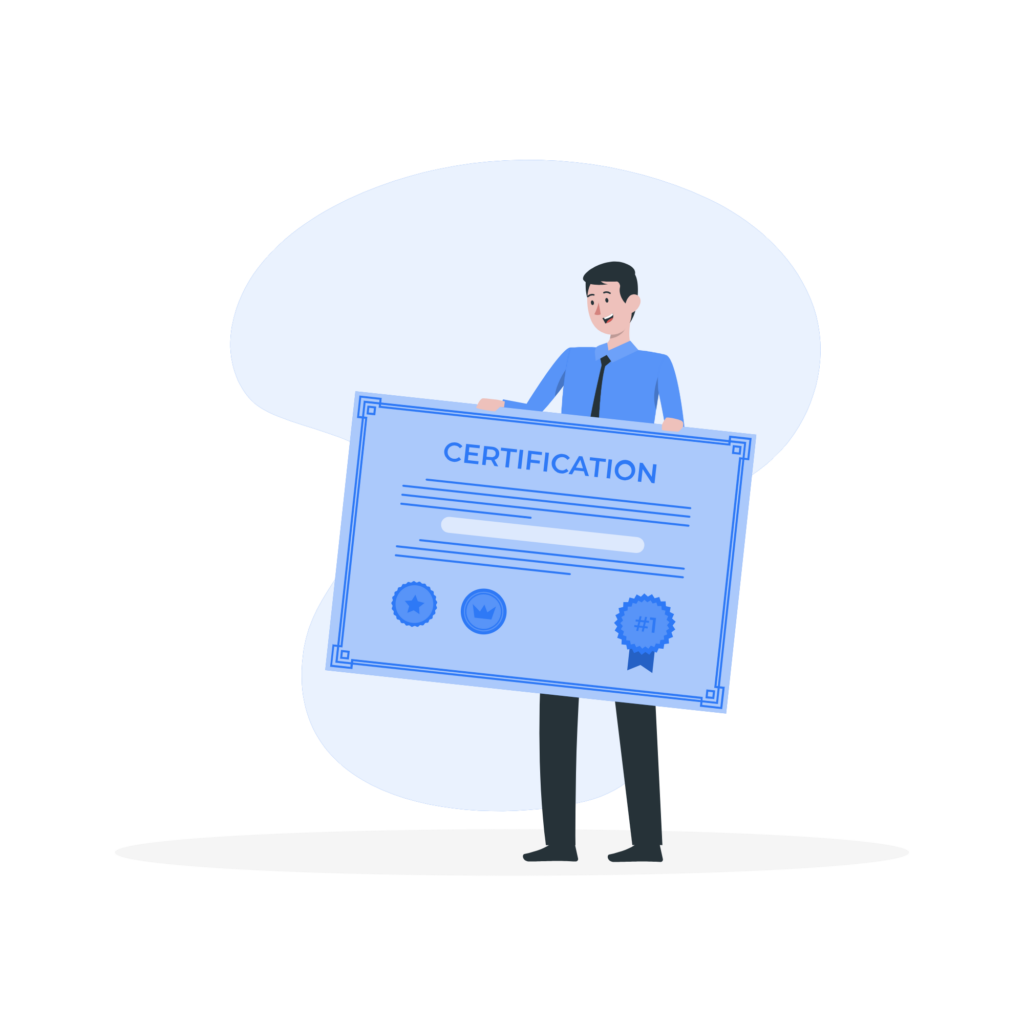The process of obtaining a license to practice medicine in the United States is both thrilling and difficult, with the United States Medical Licensing Examination (USMLE) acting as the key stepping stone. The USMLE is a beacon for American and international medical graduates, measuring the comprehensive understanding and application of medical material essential for achieving career success in medicine.
This manual is your guide to passing the USMLE, with professional advice, study strategies, and insights that will help students prepare and score better.
Decoding the USMLE: What You Need to Know
The Federation of State Medical Boards (FSMB) and the National Board of Medical Examiners (NBME) collaborate to manage the United States Medical Licensing Examination (USMLE). The test USMLE was developed in response to the rising desire for a single path to medical license for practitioners in the United States.
Prior to the USMLE, two examinations offered pathways to medical licensure. It was desirable to create a single examination method that was recognized in all states, guaranteeing that all licensed MDs satisfied the same assessment standards, despite where they had previously studied.
The FSMB is a non-profit organization, that oversees medical licenses, analyzes patient complaints, and enforces disciplinary fines on physicians. The association assists its member boards with credentialing, an investigation monitoring database, and lobbying on major medical licensure and practice issues.
The NBME, on the other hand, offers a diverse set of high-quality exams and training services suited to students, health care providers, instructors, regulators, and healthcare organizations. Collaborations with healthcare providers, educators, and test creation and research specialists help to facilitate this process.
Furthermore, the NBME creates exams for use in medical training, licensing, and certification both domestically and globally. It also conducts development and research to expand the field of medicine and assessment science, aiming to improve healthcare delivery.

Eligibility for the USMLE Steps
The Liaison Committee on Medical Education (LCME) and the Committee on Accreditation of Canadian Medical Schools (CACMS) now accredit MD-level medical education programs in Canada. Beginning July 1, 2025, CACMS will be a single accreditor for medical schools in Canada.
When this change goes into force, it will unavoidably alter the USMLE enrollment and ECFMG Certification requirements for Canadian healthcare students and graduates.
Step 1 and Step 2 CK
To be admissible, you must fit into one of the three categories:
- A medical pupil who is currently enrolled in or has graduated from an LCME-accredited medical education program in the United States or Canada that leads to the MD degree.
- A medical student who is currently enrolled or has graduated from a US medical school certified by the Commission on Osteopathic College Accreditation.
- A medical student that attends or graduated from a medical school acknowledged by the World Directory of Medical Schools.
Step 3
Eligibility requirements for Step 3 are:
- Passing results on Step 1 as well as Step 2 CK.
- An MD or DO credential from an LCME- or COCA-accredited US or Canadian school of medicine, OR an alternative of the MD degree at a medical school abroad which has been included in the World Directory of Medical Schools.
The USMLE program advises that applicants for Step 3 have completed, or are nearing completion of, a minimum of one postgraduate educational year in a recognized US graduate medical school institution that fulfills state board licensure standards.
If your eligibility for a Step changes after you complete your application but prior to your planned test date, you must immediately tell the organization that enrolled you for the exam.
If you have been suspended from the school you become ineligible for the USMLE, irrespective of the appeal status.

USMLE Step 1: Laying the Foundation
USMLE first step tests the ability to apply fundamental scientific concepts, with a focus on the theories and processes underlying health, illness, and forms of therapy. USMLE Step 1 Test questions are divided into 18 categories based on concepts and principles common to all organ systems or exclusive to one organ system.
Step 1 is a single-day test. It is broken into seven 60-minute pieces and completed in a single 8-hour testing session. The amount of multiple-choice questions (MCQs) in each block on a specific examination form may differ, but it will not exceed 40. The overall amount of elements on the exam form is limited to 280.
The USMLE Step 1 Exam assesses fundamental scientific knowledge. Some questions assess the examinee’s knowledge in general, but the bulk require the examinee to evaluate visual and tabular material, identify macroscopic and microscopic pathological and normal specimens, and solve problems using basic scientific principles.
Step 1 Breakdown: What to Expect
| System | Range, % |
|---|---|
| Human Development | 1-3 |
| Blood & Lymphoreticular/Immune Systems | 8–13 |
| Behavioral Health & Nervous Systems/Special Senses | 10–14 |
| Musculoskeletal, Skin & Subcutaneous Tissue | 7–12 |
| Cardiovascular System | 6-11 |
| Respiratory & Renal/Urinary Systems | 10–15 |
| Gastrointestinal System | 5–10 |
| Reproductive & Endocrine Systems | 9–13 |
| Multisystem Processes & Disorders | 11-16 |
| Biostatistics & Epidemiology/Population Health | 4–6 |
| Social Sciences: Communication and Interpersonal Skills | 6–9 |
Physician Tasks/Competencies
| Competency | Range, % |
|---|---|
| Medical Knowledge: Applying Foundational Science Concepts | 60–70 |
| Patient Care: History/Physical Examination & Diagnosis | 20–25 |
| Communication and Interpersonal Skills | 6–9 |
| Practice–based Learning & Improvement | 4–6 |
Discipline Specifications
| Discipline | Range, % |
|---|---|
| Pathology | 44–52 |
| Physiology | 25–35 |
| Pharmacology | 15–22 |
| Biochemistry & Nutrition | 14–24 |
| Microbiology | 10–15 |
| Immunology | 6–11 |
| Gross Anatomy & Embryology | 11–15 |
| Histology & Cell Biology | 8–13 |
| Behavioral Sciences | 8–13 |
| Genetics | 5–9 |
USMLE Step 2 CK: Clinical Knowledge Deep Dive
Step 2 CK evaluates medical expertise, abilities, and comprehension of clinical science needed for patient care under supervision, with a focus on health promotion and illness prevention.
USMLE Step 2 CK Examination is broken into eight 60-minute sections, completed in a single 9-hour testing session. The amount of questions in each block on a specific exam will differ but will never exceed 40. The total amount of questions in the overall exam is limited to 318. The test also includes at least 45 minutes of refreshment time along with a 15-minute supplementary lesson.
Step 2 CK Breakdown: What to Expect
| System | Range, % |
|---|---|
| Human Development | 2–4 |
| Immune System | 3–5 |
| Blood & Lymphoreticular System | 4–6 |
| Behavioral Health | 6–8 |
| Nervous System & Special Senses | 6–8 |
| Musculoskeletal System/Skin & Subcutaneous Tissue | 6–10 |
| Cardiovascular System | 8–10 |
| Respiratory System | 7–9 |
| Gastrointestinal System | 7–9 |
| Renal & Urinary System & Male Reproductive | 4–6 |
| Pregnancy, Childbirth & the Puerperium | 4–6 |
| Female Reproductive System & Breast | 4–6 |
| Endocrine System | 4–6 |
| Multisystem Processes & Disorders | 4–6 |
| Biostatistics & Epidemiology/Population Health/Interpretation of Medical Literature | 3–5 |
| Social Sciences: Legal/Ethical Issues & Professionalism/Systems-based Practice & Patient Safety | 10–15 |
Physician Tasks/Competencies
| Competency | Range, % |
|---|---|
| Patient Care: Laboratory/Diagnostic Studies | 13–17 |
| Patient Care: Diagnosis | 16–20 |
| Patient Care: Prognosis/Outcome | 5–9 |
| Patient Care: Health Maintenance/Disease Prevention | 8–12 |
| Patient Care: Pharmacotherapy | 8–12 |
| Patient Care: Clinical Interventions | 6–10 |
| Patient Care: Mixed Management | 12–16 |
| Practice-based Learning & Improvement | 3–5 |
| Professionalism | 5–7 |
| Systems-based Practice & Patient Safety | 5–7 |
Step 2 CK Discipline Specifications
| Competency | Range, % |
|---|---|
| Medicine | 50–60 |
| Surgery | 25–30 |
| Pediatrics | 20–25 |
| Obstetrics & Gynecology | 10–20 |
| Psychiatry | 10–15 |
USMLE Step 3: Demonstrating Readiness for Independent Practice
Step 3 is intended to examine the knowledge and abilities of physicians taking on autonomous responsibility for delivering general health services to patients, with a focus on managing patients in outpatient settings.
USMLE Step 3 The exam material represents a data-driven model of general medical care in the US. The test simulates clinical scenarios that an average, as-yet indistinguishable clinician could face in a given setting. It is made up of questions with multiple choices (MCQs), sometimes called items, and computerized case examples.
The Step 3 test is divided into two days: Foundations of Independent Practice (FIP) on the first day and Advanced Clinical Medicine (ACM) on the second.
The second day’s exam session lasts around nine hours. This day of testing begins with a 5-minute optional lesson, then moves onto 180 multiple-choice questions broken down into six sections of 30 items, each with 45 minutes to complete. The second day contains a 7-minute CCS instruction. This is accompanied by 13 case modeling, each with a maximum duration of ten to twenty minutes of actual time. There is a limit of 45 minutes available for breaks.

Day 1: Step 3 Foundations of Independent Practice (FIP)
This exam day focuses on assessing knowledge of fundamental clinical and scientific principles required for successful health care. The topics covered include the application of foundational sciences, an understanding of biological statistics and population wellness, and interpretation of medical literature; and the application of social sciences, such as interpersonal and communication abilities, ethics in medicine, systems-based practice, and safety for patients.
The test day additionally involves an assessment of knowledge of diagnostics and management, with a special emphasis on history and physical exam, diagnosis, and the use of diagnostic tests.
Day 2: Step 3 Advanced Clinical Medicine (ACM)
This exam day assesses the ability to use an in-depth understanding of health and illness in connection with patient treatment and disease progression throughout time. The content areas addressed include diagnostic and management knowledge evaluation, with a specific emphasis on prognosis and results, maintaining health and screening, treatments, and clinical decision making. Understanding of historical background and physical exam, diagnosis, and the application of diagnostic investigations is also evaluated.
Step 3 Breakdown: What to Expect
Successful completion of at least one year of postgraduate training in a school certified by the Accreditation Council for Graduate Medical Education or the American Osteopathic Association ought to prepare you for Step 3. The intended objective of the USMLE procedure is a broad, unrestrained license for practicing medicine without supervision.
Although you may have already begun specialty training, you will be required to act as a general, undifferentiated physician during this test. You are an employee of a standalone practice that is linked with many managed care companies. Your office has normal operating hours. You are able to admit clients to a 400-bed local hospital that serves both urban and rural regions. The hospital offers typical diagnosis, radiologic, and treatment alternatives, such as ICUs and heart surgery. There’s a delivery and labor suite. A highly equipped emergency room connects to the hospital, and healthcare helicopters are available for emergency transport to a regional trauma center.
The physician-patient contacts stated in Step 3 are often related with the setting in which the interaction happens. There are three locations of care:
- Ambulatory
- Inpatient Facility
- Emergency Department
Step 3 patients represent the variety of the health care population in terms of gender, age, cultural group, and employment. The patient demographic mix is meant to reflect data obtained from multiple national health care datasets in the United States.
Step 3 MCQ Test Content Specifications
| System | Range, % |
|---|---|
| Human Development | 1–3 |
| Immune System, Blood & Lymphoreticular System, and Multisystem Processes/Disorders | 6–8 |
| Behavioral Health | 4–6 |
| Nervous System & Special Senses | 8–10 |
| Skin & Subcutaneous Tissue | 4–6 |
| Musculoskeletal System | 5–7 |
| Cardiovascular System | 9–11 |
| Respiratory System | 8–10 |
| Gastrointestinal System | 6–8 |
| Renal/Urinary & Male Reproductive Systems | 4–6 |
| Pregnancy/Childbirth & Female Reproductive System & Breast | 7–9 |
| Endocrine System | 5–7 |
| Biostatistics & Epidemiology/Population Health & Interpretation of the Medical Literature | 11–13 |
| Social Sciences: Communication Skills/Ethics/Patient Safety | 7–9 |
Step 3 CCS Test Content Specifications
| Category | Covered |
|---|---|
| Immune System | √ |
| Blood & Lymphoreticular System | √ |
| Behavioral Health | √ |
| Nervous System & Special Senses | √ |
| Skin & Subcutaneous Tissue | √ |
| Musculoskeletal System | √ |
| Cardiovascular System | √ |
| Respiratory System | √ |
| Gastrointestinal System | √ |
| Renal & Urinary System | √ |
| Pregnancy, Childbirth, & the Puerperium | √ |
| Female Reproductive & Breast | √ |
| Male Reproductive | √ |
| Endocrine System | √ |
| Multisystem Processes & Disorders | √ |
Step 3 MCQ Physician Tasks/Competencies Specifications
Foundations of Independent Practice (Day 1)
| Competency | Range, % | Covered |
|---|---|---|
| Medical Knowledge: Applying Foundational Science Concepts | 11–12 | √ |
| Patient Care: Diagnosis | 33–36 | √ |
| History/Physical Exam | 5–9 | √ |
| Laboratory/Diagnostic Studies | 9–12 | √ |
| Diagnosis | 6–10 | √ |
| Prognosis/Outcome | 8–11 | |
| Patient Care: Management | 32–35 | |
| Health Maintenance/Disease Prevention | 6–11 | |
| Pharmacotherapy | 9–13 | |
| Clinical Interventions | 5–9 | |
| Mixed Management | 6–11 | |
| Practice-based Learning & Improvement | 11–13 | √ |
| Communication / Professionalism / Systems-based Practice & Patient Safety | 7–9 | √ |
Advanced Clinical Medicine (Day 2)
| Competency | Range, % | Covered |
|---|---|---|
| Medical Knowledge: Applying Foundational Science Concepts | 11–12 | |
| Patient Care: Diagnosis | 33–36 | √ |
| History/Physical Exam | 5–9 | |
| Laboratory/Diagnostic Studies | 9–12 | |
| Diagnosis | 6–10 | |
| Prognosis/Outcome | 8–11 | √ |
| Patient Care: Management | 32–35 | √ |
| Health Maintenance/Disease Prevention | 6–11 | √ |
| Pharmacotherapy | 9–13 | √ |
| Clinical Interventions | 5–9 | √ |
| Mixed Management | 6–11 | √ |
| Practice-based Learning & Improvement | 11–13 | |
| Communication and Professionalism | 7–9 |
Step 3 CCS Physician Tasks/Competencies Specifications
| Competency | Covered |
|---|---|
| Patient Care: Diagnosis | √ |
| History/Physical Exam | √ |
| Laboratory/Diagnostic Studies | √ |
| Diagnosis | √ |
| Prognosis/Outcome | √ |
| Patient Care: Management | √ |
| Health Maintenance/Disease Prevention | √ |
| Pharmacotherapy | √ |
| Clinical Interventions | √ |
| Mixed Management | √ |
| Surveillance for Disease Recurrence | √ |
Prep Smart: Your USMLE Success Blueprint
Practice exams are the most effective strategy to enhance your ability to endure an 8-hour examination. Use practice tests to discover areas of deficiencies and strengths, as a guide for directing studies.
During your 90-day enrollment period, Prometric provides practice sessions with brief tutorials and three one-hour blocks of roughly 40 exam items each. After completion, a copy of the accurate score is displayed. The chance to become acquainted with the exam place may aid in reducing anxiety on test day.
For individuals who do not want to make use of a Prometric practicing space, it is critical to imitate your testing setting when taking practice examinations. An optimum test location will need to be a calm spot with no disruptions or additional noise, possibly outside of your house. This could be a library, a restricted classroom, or another reserved, quiet area with “testing in progress” written on the entrance.
Practice test resources:
- UWorld Question Banks & Educator Resources
- Kaplan’s USMLE® Prep Courses
- Comprehensive Basic Science Self-Assessment Exam
- USMLE Practice Examination
- NBME Orientation
Strategic Study Schedules: Mapping Your USMLE Journey
Creating a study regimen for the USMLE exam is crucial for a variety of reasons. It holds you liable, helps you organize your time more efficiently, and ensures that you address all relevant topics. A tailored plan takes into account your learning style, pace, and past knowledge, allowing you to study more efficiently and with less stress.
List Out the USMLE Topics
Before you begin building your study program—list all of the topics offered on the USMLE. The test includes a wide range of disciplines, including pathology, biochemistry, anatomy, and ethics.
Your next step should be to determine where to find information on these issues. Each topic will have several subtopics and subtleties that may be addressed in additional preparation resources, review courses, and scholarly papers. You can refer to review books by well-known authors such as GoldUSMLE, First Aid, Kaplan, or Pathoma, as well as recognized medical forums wherein peers and mentors exchange insights and updates.
Rank Topics from Weakest to Strongest
Once you’ve compiled the list of topics, rank them depending on your present comprehension and comfort level. This necessitates a frank self-evaluation. If you’re unsure how to evaluate oneself, a diagnostic exam might assist.
Focusing on areas of weakness at the start of your study time provides two primary benefits. First, your motivation and energy levels improve, allowing for more focused and successful study sessions. Second, covering the difficult areas first allows for additional time for repeated study, which will help you comprehend the material as the test advances.
Be careful not to focus too much effort on one weak section at the cost of others; maintaining a balance is essential.

Allocate 1-3 Study Days per Topic
Now comes the quantitative element of the study plan: designating certain days for each topic. A typical advice is to set aside 1-3 days each course. However, this figure can vary depending on a variety of factors such as topic difficulty, your level of familiarity with the topic at hand, and the amount of study time available.
A more in-depth look at your study regimen would entail further breaking down the 1-3 days.
While structure is beneficial, being overly strict can have the opposite effect. Your calendar should provide flexibility for unanticipated events, difficult topics that require additional time, and relaxation breaks.
Execute Daily Study Plan
At this point, you’ve established a specific strategy, recognized your weak subjects, and assigned time to each. The next essential step in your USMLE preparation journey is to carry out the daily study schedule.
A typical day consists of three primary phases: morning focused study, afternoon practice questions, and late afternoon/evening review and consolidation.
This allocation takes use of your intellectual cycles, utilizing moments when you’re most attentive for the most difficult mental tasks.
The materials used during the sessions are crucial. They can include everything from books and medical publications to internet resources, footage, and practice examinations. It is best to be equipped with a variety of materials to accommodate various methods of learning and make the study process interesting.
Resource Roundup: Best Tools for Your USMLE Prep
Your choice of materials can either make or break overall USMLE due diligence, so choose what’s best for you.
The samples are accessible for free on the USMLE homepage. You can get study materials through NBME Unlocking Assessment or an online NBME Self-Assessment test. All USMLE examinees can access practice resources and self-assessment tools.
BoardVitals
BoardVitals is a particularly comprehensive study resource for the USMLE. It consists of 3100 items for self-assessment. BoardVitals may be utilized in two modes: timed and review mode. Students can solve problems from question banks on a regular basis and assess their rationales in Review mode. The explanations are extremely detailed and can be used to take notes with the help of important points or memory cards.
Furthermore, you may complete the QBanks in Timed Mode (roughly 1 hour each block) to practice time management for the test. This material repeatedly covers high-yield USMLE subjects, shifting your attention to them.
First Aid USMLE Textbooks
First Aid is a comprehensive textbook for USMLE due diligence, created by students who successfully completed the exam and authorized by leading residency heads. This textbook concentrates on all high-yield subjects and ideas found on the USMLE
Candidates can utilize this book in conjunction with the BoardVitals question bank. First, read the content in the First Aid textbook, and then complete the BoardVitals Qbank. Note, the First Aid USMLE booklet is a review book and does not include in-depth explanations of the topics. As a result, some experts recommend taking notes on the clarifications provided in BoardVitals and then revisiting the topic in the First Aid textbook.
Instead of taking traditional notes, highlight essential topics and mark them in this book.
USMLE-Rx
USMLE Rx is an e-learning platform based on the well-known first aid textbooks. The portal provides a variety of study aids, including problem banks, cards, even instructional videos. Additional features include Rx Bricks, which are small modules that condense significant subjects in a more concise and digestible way.
At the end of each brief module, there are a few brief multiple-choice questions to ensure that you have a fundamental conceptual comprehension of the content. Bricks also feature tables, graphs, and drawings that may be whited out to serve as labeling tests.
Other essential aspects of USMLE Rx comprise flashcards and 1-3 minute long “express” films that give students a simplified video representation of a key topic. These Express videos clarify more complex ideas with drawings and charts, and can clarify or highlight the most significant takeaway in a particular topic.

Anxiety Management: Keeping Calm on the Road to USMLE
There’s something fundamentally soothing about knowing exactly what you have to do every day to be properly prepared for the exam. You don’t have to lay awake at night worrying if you’re studying the right stuff or if you have sufficient time to complete everything with an organized schedule; that anxiety goes away. Each day you stick to your program, you go a bit closer to being completely prepared, which may dramatically lessen your tension and worry leading up to your big day.
Other suggestions that may come in handy:
- Follow the energy stream. Schedule the most difficult portion of your learning day when you feel most awake (i.e., are you more of a morning or the evening type) and plan appropriately.
- Mute alerts. Disabling all phone and laptop notifications will improve your ability to focus.
- Don’t be isolated. Humans require interaction, and focused study time may be quite lonely. Make sure you’re interacting with other people in some way during your designated study time.
- Find study mates. Many students gain from having a study companion. Arrange to get together with a fellow student to go over a topic, ask each other inquiries, explain a topic to one another, get a white board, and deliver “lectures” to each other, etc.
- Take time away from education. A study program should include study breaks. Time off allows for more productive studying. Take a minimum of a full day off each week. Schedule five-minute breaks every 45 minutes to imitate the testing environment.
- Rest. Set a sleep routine that corresponds to the time you wake up on test day.
- Don’t compare. Someone will always study more (or less) than you. While you should listen to others’ advice, you’re aware of when you feel most productive when studying—so do what’s best for you.
- Resist the impulse to postpone the exam date. There’s a stage where further study is unproductive. Although the prospect of a few extra days of studying may seem appealing, believe in your skills and the success of your study regimen.
Changing the exam date might lower your confidence and increase your worry. You will never feel completely prepared; most students “peak” after 5-6 weeks of focused study time.
Taking the Plunge: Registration and Scheduling
When applying to take the USMLE, you must first submit an application to the relevant organization. Step 1, Step 2 CK, and Step 3 are each conducted in Prometric facilities. Step 3 is solely administered in the United States and its territories. Check the Prometric website to discover the test facility nearest your location and to arrange an appointment.
Appointments at certain testing facilities fill up rapidly. Examinees should schedule at their desired testing location as soon as they obtain their scheduling permission.
When registering for the exam, you must specify an eligibility period within which you want to test. Once the registration process is complete, you will get an email with a scheduling permission that includes your eligibility period. After getting the scheduling permit, go to the Prometric website and arrange a test date.
You may reschedule throughout your qualifying period; however, if you seek a change within 45 calendar days of your planned appointment, you may be charged a fee. If you are unwilling to test within the specified period, approach the organization that enrolled you for the exam to request a one-time consecutive eligibility term extension. This service is not free.
If you fail to take the exam during your initial or prolonged eligibility time frame, you must reapply with an additional application and fee(s). Fees are non-transferable.
Contacts for Application and Registration Inquiries
| USMLE Step | Applicant | Organization |
|---|---|---|
| Step 1 and Step 2 CK | Students and graduates of medical schools in the US or Canada | NBME 3750 Market Street Philadelphia, PA 19104-3102 Website: nbme.org Telephone: (215) 590-9700 Email: [email protected] |
| Step 1 and Step 2 CK | Students and graduates of medical schools outside the US and Canada | ECFMG 3624 Market Street Philadelphia, PA 19104-2685 Website: ecfmg.org Telephone: (215) 386-5900 Email: [email protected] |
| Step 3 | All medical school graduates who have passed Step 1 and Step 2 CK | FSMB Assessment Services 400 Fuller Wiser Road Euless, TX 76039-3856 Website: fsmb.org Telephone: (817) 868-4041 Email: [email protected] |
Post-USMLE: Understanding Your Scores and Next Steps
The USMLE Management Committee determines the minimal passing score. They analyze data for each part in the sequence around once every four years to determine whether to adjust the suggested minimum passing score.
The USMLE results are published on a three-digit scale. Current necessary passing scores are:
- Step 1: Pass/fail results will be reported only for tests completed on or following January 26, 2022. On a three-digit scale, 196 is the passing score.
- Step 2 CK: 214
- Step 3: 200
Computer-based examination results are normally accessible within four weeks after the test date. However, a variety of causes may cause a delay in score reporting. When choosing a test date and enquiring about results, expect a minimum of eight weeks to get news that the result report is ready.
Once your score is ready, you will get an email. Your score record will be accessible via the web page of the entity that enrolled you for your exam for a period of 365 days from the day of the email announcement.
Reporting to Third Parties
The NBME reports USMLE results to medical schools. If you do not want your Step 1 and Step 2 CK results disclosed to your medical school, write a request to [email protected] at least 10 working days before the test date. Each exam administration requires a separate request. Step 3 requires you to select your reporting preferences in your application.
The ECFMG may send USMLE results to overseas medical colleges for their pupils and graduates. If you do not want your Step 1 and Step 2 CK results published to your medical school, then make a request for every examination administration using ECFMG’s Interactive Web Applications (IWA) at least 10 working days before your planned test date.
USMLE by the Numbers: Performance Insights
The USMLE provides ongoing testing for its Step 1, Step 2, Clinical Knowledge (CK), and Step 3 tests, which are all administered via computer-based examinations at Prometric USMLE test centers. These tests are available at about 335 locations in the United States and Canada, with more than 100 facilities globally and four U.S. school of medicine sites.
Step 1 and Step 2 CK may be taken anywhere and in any sequence, as long as the examinee satisfies the qualifying requirements. Step 3 is only accessible in the United States and requires the successful completion of the previous two steps. State medical boards can have defined timetables for completing all USMLE phases.
The USMLE gives clear pass/fail results for each examinee based on predetermined performance levels. These criteria assure uniformity between exam versions, as described in the USMLE Score Interpretation Guidelines.
Step 1
| Examinees from US/Canadian Schools | 2022 Number Tested | 2022 Percent Passing | 2023 Number Tested | 2023 Percent Passing |
|---|---|---|---|---|
| MD Degree | 24,317 | 91% | 25,146 | 90% |
| 1st Takers | 22,828 | 93% | 23,100 | 92% |
| Repeaters | 1,489 | 71% | 2,046 | 70% |
| DO Degree | 4,722 | 89% | 4,913 | 86% |
| 1st Takers | 4,659 | 89% | 4,798 | 87% |
| Repeaters | 63 | 67% | 115 | 60% |
| Total | 29,039 | 91% | 30,059 | 90% |
| Examinees from Non-US/Canadian Schools | 2022 Number Tested | 2022 Percent Passing | 2023 Number Tested | 2023 Percent Passing |
|---|---|---|---|---|
| 1st Takers | 22,030 | 74% | 22,611 | 72% |
| Repeaters | 2,926 | 45% | 3,530 | 47% |
| Total | 24,956 | 71% | 26,141 | 68% |
Step 2 CK
| Examinees from US/Canadian Schools | 2021-2022 Number Tested | 2021-2022 Percent Passing | 2022-2023 Number Tested | 2022-2023 Percent Passing |
|---|---|---|---|---|
| MD Degree | 24,632 | 98% | 23,500 | 98% |
| 1st Takers | 24,205 | 99% | 23,018 | 98% |
| Repeaters | 427 | 71% | 482 | 71% |
| DO Degree | 5,199 | 97% | 4,712 | 96% |
| 1st Takers | 5,177 | 97% | 4,666 | 96% |
| Repeaters | 22 | 73% | 46 | 61% |
| Total | 29,831 | 98% | 28,212 | 97% |
| Examinees from Non-US/Canadian Schools | 2021-2022 Number Tested | 2021-2022 Percent Passing | 2022-2023 Number Tested | 2022-2023 Percent Passing |
|---|---|---|---|---|
| 1st Takers | 12,708 | 89% | 14,395 | 88% |
| Repeaters | 1,369 | 57% | 1,411 | 60% |
| Total | 14,077 | 86% | 15,806 | 86% |
Step 3
| Examinees from US/Canadian Schools | 2022 Number Tested | 2022 Percent Passing | 2023 Number Tested | 2023 Percent Passing |
|---|---|---|---|---|
| MD Degree | 22,336 | 97% | 22,405 | 97% |
| 1st Takers | 21,633 | 98% | 21,703 | 97% |
| Repeaters | 703 | 76% | 702 | 77% |
| DO Degree | 100 | 96% | 104 | 95% |
| 1st Takers | 98 | 96% | 100 | 95% |
| Repeaters | 2 | † | 4 | † |
| Total | 22,436 | 97% | 22,509 | 97% |
| Examinees from Non-US/Canadian Schools | 2022 Number Tested | 2022 Percent Passing | 2023 Number Tested | 2023 Percent Passing |
|---|---|---|---|---|
| 1st Takers | 10,993 | 91% | 11,500 | 92% |
| Repeaters | 1,294 | 64% | 1,264 | 64% |
| Total | 12,287 | 89% | 12,764 | 89% |
Conclusion: Embarking on Your Medical Career with Confidence
As we complete our Ultimate Guide to the USMLE, it’s vital to consider the adventure you’re about to embark on. The USMLE is more than simply a set of examinations; it is a critical step toward achieving your goal of becoming a physician with a license in the US. Understanding the framework and objective of the USMLE, rigorously preparing with the correct tactics and resources, and successfully managing test anxiety are all steps toward success.
Remember that this journey is a marathon, not a sprint. It demands patience, tenacity, and a good outlook. As you move ahead, keep your targets in mind and believe in your preparedness. You are doing more than simply preparing for a test; you are laying the groundwork for your future medical profession.
FAQs about the USMLE
-
How many questions are on USMLE Step 1?
The amount of questions each block on a specific examination form may differ, but it will not exceed 40. The overall total of elements on the exam form is limited to 280. -
How long is USMLE Step 1?
Step 1 is a one-day test. It is broken into seven 60-minute pieces and completed in a single 8-hour testing session. -
How do I study for USMLE Step 1?
Create a clear study strategy and spread your efforts over several months. Use high-quality resources such as First Aid for the USMLE Step 1, UWorld Question Bank, Pathoma, and SketchyMedical. Use cards and quizzes, review content on a regular basis to reinforce information, and evaluate your progress using full-length practice examinations. -
How long is USMLE Step 2?
USMLE Step 2 CK Exam is a one-day exam. It is broken into eight 60-minute pieces and completed in a single 9-hour testing session. The amount of questions for every segment on a specific exam will vary yet will never exceed 40. The number of questions in the overall exam will not go over 318. -
What does my USMLE score mean?
Your USMLE score assesses the depth of medical information and skills students possess. Step 1 and Step 2 CK scores demonstrate how well you grasp and apply key medical principles, with higher scores boosting the residency applications by proving that you’re competent to program directors. Although Step 1 has been converted to a pass/fail approach to reduce its high-stakes character, Step 2 CK scores are now given more weight for performance evaluation. The Step 3 scores determine your preparedness for autonomous medical practice.



